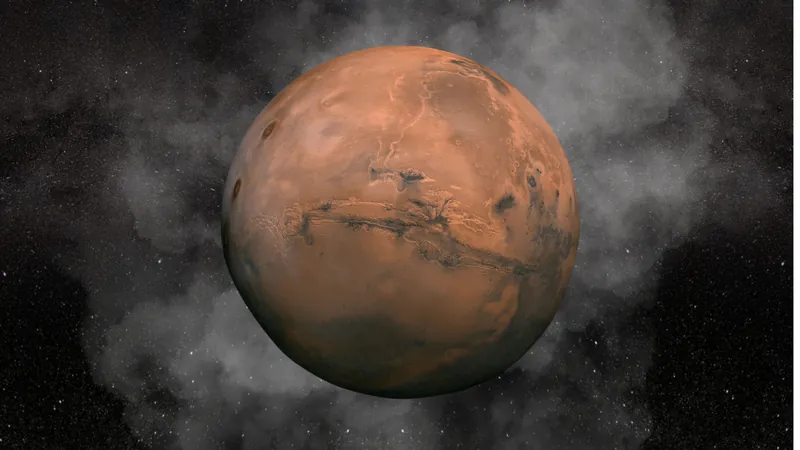
Mars' Lost Atmosphere: New Evidence Suggests It's 'Hiding in Plain Sight'
2024-09-25
Author: Lok
Introduction
New breakthroughs in Martian atmospheric research reveal that the elusive remnants of Mars' once-thick atmosphere may be lurking within its own soil, specifically absorbed by clay minerals. This intriguing hypothesis could shed light on how Mars transformed from a potentially habitable planet with flowing water to the desolate world we see today, possibly paving the way for understanding why Earth evolved so differently.
Historical Context
Scientists have long known that Mars wasn't always the barren landscape now traversed by NASA's Perseverance and Curiosity rovers. Historical data indicates that liquid water was abundant on the planet's surface early in its 4.6 billion-year history. However, for liquid water to exist, Mars needed a protective atmosphere to prevent it from freezing or evaporating away. The critical question that has puzzled researchers for decades remains: What happened to Mars' atmosphere?
Recent Findings
A recent study published in Science Advances suggests that the answer might lie beneath the Martian surface. Led by geologists from the Massachusetts Institute of Technology (MIT), the research posits that, over three billion years ago, water from the surface began to permeate various rock types, initiating chemical reactions that removed carbon dioxide from the atmosphere. This carbon dioxide could have converted into methane and become trapped within clay minerals, effectively sequestering the planet's atmospheric gases.
Insights from Earth
According to Oliver Jagoutz, a professor at MIT, "The processes we observed on Earth likely occurred on Mars as well. Vast amounts of atmospheric carbon dioxide could have transformed into methane and been stored in the clays." This finding raises the exciting possibility that traces of methane could still exist on Mars today, potentially serving as an energy source for future exploration missions.
Methodology
Interestingly, the research team began their investigation by studying Earth’s geological processes before applying their knowledge to Mars. They focused on smectite, a type of clay mineral adept at capturing and holding carbon. On Earth, smectites form through the movement of tectonic plates, which work to expose these clays to the atmosphere, helping to regulate climate by removing greenhouse gases.
Geological Observations on Mars
Upon examining Martian geology, Jagoutz noticed that smectite was also present on Mars. However, it posed a major question—lacking tectonic activity, how did these folded clay minerals form? To answer this, the team looked at ancient igneous rocks found on Mars, particularly low-silica ultramafic rocks known for weathers into smectite on Earth.
Model Development
The researchers utilized existing data on how water interacts with these ultramafic rocks on Earth to develop a model for Mars. Their findings suggested that water could have permeated the Martian crust and interacted with a mineral called olivine—a prevalent component of ultramafic rocks. This interaction would have not only released hydrogen but also created methane as a byproduct, leading to further mineral transformations.
Scale of Findings
The crucial aspect of their findings is the potential scale of methane storage within Martian clays. The team estimated that for Mars to have extracted enough carbon dioxide from its ancient atmosphere, it would require a thick layer of smectite over 3,600 feet deep. "The volume of clay on Mars might consistently explain a significant portion of its initial carbon dioxide being sequestered as organic compounds," noted Joshua Murray, lead author of the study.
Conclusion
Understanding the fate of Mars' atmosphere is critical not only for grasping its history but also for shaping future exploration and the search for extraterrestrial life. Could this newfound perspective inspire manned missions to tap into these hidden resources? Only time will tell. As we delve deeper into the mysteries of the Red Planet, we might find that remnants of ancient life and a once-thriving atmosphere are waiting to be uncovered, right beneath our feet.




 Brasil (PT)
Brasil (PT)
 Canada (EN)
Canada (EN)
 Chile (ES)
Chile (ES)
 España (ES)
España (ES)
 France (FR)
France (FR)
 Hong Kong (EN)
Hong Kong (EN)
 Italia (IT)
Italia (IT)
 日本 (JA)
日本 (JA)
 Magyarország (HU)
Magyarország (HU)
 Norge (NO)
Norge (NO)
 Polska (PL)
Polska (PL)
 Schweiz (DE)
Schweiz (DE)
 Singapore (EN)
Singapore (EN)
 Sverige (SV)
Sverige (SV)
 Suomi (FI)
Suomi (FI)
 Türkiye (TR)
Türkiye (TR)